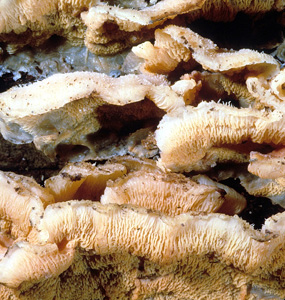Merulius tremellosus

Image Courtesy of Eleanor Yarrow
| Click to Enlarge |
| Click For Image Gallery |
|
Group of Fungi: Crust Fungi Family: Meruliaceae Latin Name: Merulius tremellosus Schrad. Synonym(s): Phlebia tremellosa (Schrad.) Nakasong & Burds. Common Name: Trembling Merulius Description: Thin, flattened structure, spreading over the woody substrate upon which it occurs, 1–3 in (2.5–7.5 cm) wide and 1/64–1/8 (0.05–0.3 cm) thick, flexible, margins often upturned and projecting as shelf-like caps up to 3/4 in (2 cm) beyond the substrate, surface of caps white to pale yellow, hairy; spore-bearing surface consisting of a network of interconnected ridges that form irregular pores, gelatinous to waxy-looking, reddish orange to salmon-pink; spores white in mass. Biological Role: Decomposer of wood. Habitat: On decaying logs and stumps in broadleaf forests; usually found on the lower, less exposed side. Geographical Distribution: Found throughout North America. Comments: Merulius tremellosus is one member of a large and diverse assemblage of fungi that often are often overlooked in nature but have considerable ecological importance as decomposers of wood or, in some instances, as parasites of trees. Most are not easy to identify, but the gelatinous to waxy-looking spore-bearing surface of Merulius tremellosus is distinctive. |
| Go Back |